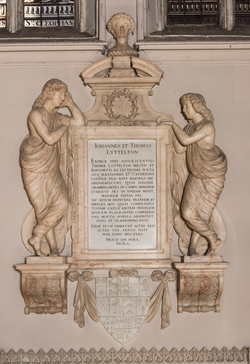How you can use this image
This image can be used for non-commercial research or private study purposes, and other UK exceptions to copyright permitted to users based in the United Kingdom under the Copyright, Designs and Patents Act 1988, as amended and revised. Any other type of use will need to be cleared with the rights holder(s).
Review the copyright credit lines that are located underneath the image, as these indicate who manages the copyright (©) within the artwork, and the photographic rights within the image.
The collection that owns the artwork may have more information on their own website about permitted uses and image licensing options.
Review our guidance pages which explain how you can reuse images, how to credit an image and how to find images in the public domain or with a Creative Commons licence available.
Notes
Add or edit a note on this artwork that only you can see. You can find notes again by going to the ‘Notes’ section of your account.
Title
Monument to Sir Heneage Finch (1580–1631)
Date
1632
Medium
Carrara marble
Measurements
H 243 x W (?) x D (?) cm
Accession number
A.184-1969
Acquisition method
gifted by the Rector and Churchwardens of the Parish of Eastwell with Broughton Aluph
Work type
Monument
Inscription description
inscription translation: To Heneage Finch,the radiant knight who served London as a Recorder for decades, Member of Parliament, and under King Charles Speaker of the House of Commons. To Moyle and Elizabeth Finch, the latter having survived her husband, and elevated with the titles of the Viscountess of Maidstone and Countess of Winchilsea. To the best son, husband, employer and friend, from Elizabeth his second wife, who came from the ancient family of Cradock, one of two daughters, having survived her husband by two years two months and seven days. He most serenely gave up his soul into the hands of his Saviour when he was taken away by the dropsy on the 5th September 1631. He lived fifty years eleven months and five days. Francis his brother, and heir (together with Thomas Twisden his brother-in-law) erected this small monument with enormous sorrow and grief. Alas, you, (o Lord who will never die) have assigned too hastily this burial amongst those still living. Renowned virtue never denies death nor does measured faith, unsurpassed zeal and gracious justice. Among those who were best versed in religious text, you were second to none in virtue. / Taken into the heavens by the Lord, how envious are we who survive. They will hardly see your equal on earth in future times.; original inscription: HENEAGIO FINCH / Equiti aurato, Servienti ad Legem Recordatori / per decennium Londinensi: / Ac Parlamentario, in secundis Sereniss: Caroli Regis / Ordinum Comitijs Proloquutori: / MOILI FINCH et ELIZABETHÆ / (quae viro superstes vicecometissae Maidston et / comitissae de Winchilsey dignitatibus aucta) / FILIO, OPTIMO, PATRONO, MARITO, AMICO VIRO / Ex Elizabetha coniuge secunda, / Antiquo Cradocorum genere orta, binis susceptis filiabus; / ac peracto iusti coniugij biennio. M. VII. D. XX. / Spiritum in manus Salvatoris sui, cui constantissime in = / servivit, placidissime (dum hydrope corripitur) resolvit / V Die Dec: Ao. CHRISTI. M. D. C. XXXI. / Vixit Annos L Men: XI Di: V / Franciscus frater natu affectu minimus (vna cum Tho: / Twisden consobrino) ex testamenta hæres modicum hoc / ingentis Desiderij et Doloris / Monumentum P. / Habes (ô nunquam moriture) heu cito nimium / Quem ipse in vivis dictitasti tumulum: / Mori nempe negavit / Virtus inclyta, intemerata fides, / Assiduitas invicta, alma Iustitia. / Inter Primos qui pie Literatus, / Nulli Bonitate Secundus extitisti. / Abrepto in coelis A Dño quid invidemus. / Cui parem in terris posteri vix videbunt.'








